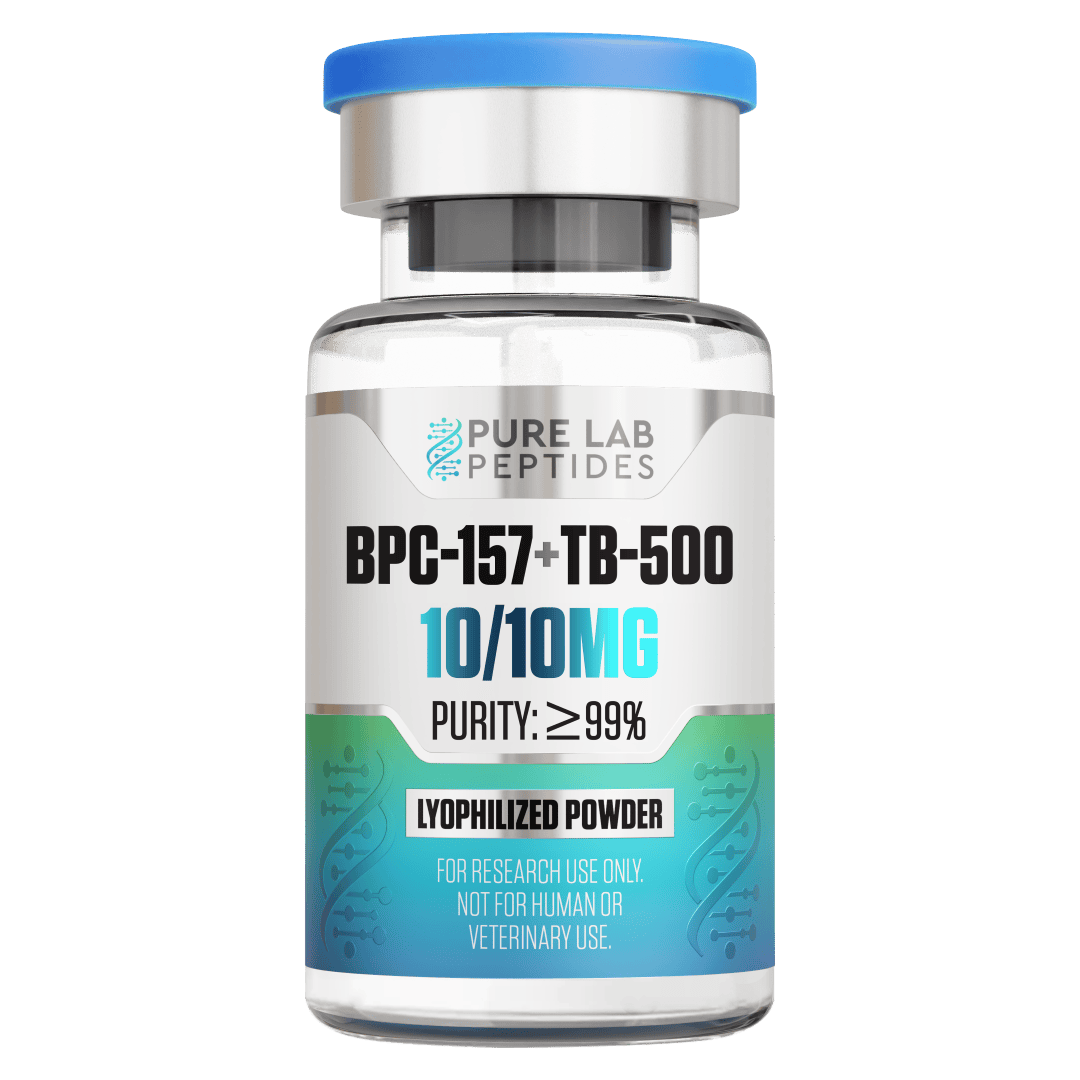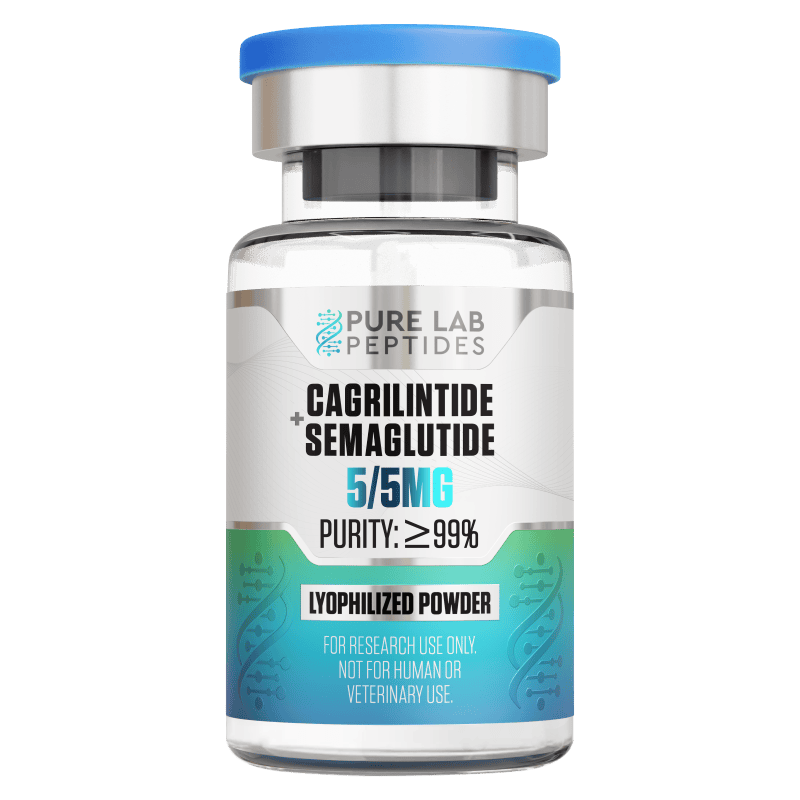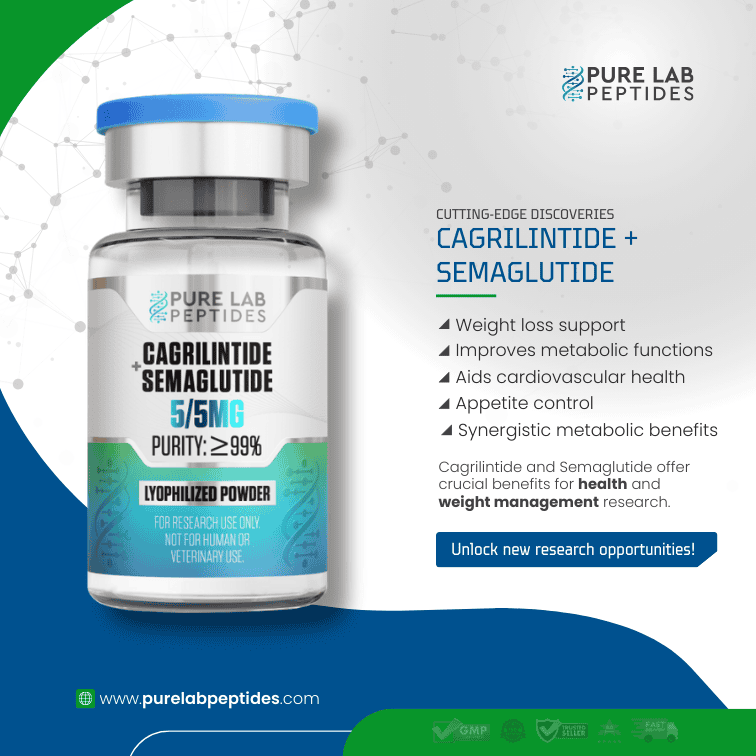
Peptides Explained: Your Ultimate Guide to Understanding Peptides
Dive deep into peptides, their roles in health, and how they’re changing medicine and skincare.

Place your order before 12 PM PST for same-day dispatch.
Enjoy complimentary shipping on orders exceeding $200.
Our dedication to service defines every interaction.
We provide peptides and proteins with over 99% purity.




Pure Lab Peptides offers an extensive catalog of premium peptides designed for precision in research. With rigorous quality control and a focus on purity, our products set the standard for reliability and performance.
Our cutting-edge labs ensure the highest quality synthesis.
Each peptide batch is meticulously tested for consistency.
We adhere to strict regulations for research purposes only.






Trusted by Researchers Worldwide
Our synthesis process ensures high purity and bioavailability for accurate results.
Get your peptides quickly with our reliable delivery service.
Our expert team is here to answer your questions and assist with your selection.
Stay at the forefront of peptide research with our latest articles, updates, and case studies.

Dive deep into peptides, their roles in health, and how they’re changing medicine and skincare.

Discover the vital role of peptides in biology, from their structure and functions to their therapeutic applications and importance in disease treatment.

Explore the advancements in peptide research and development, highlighting its revolutionary impact on therapeutic options, synthesis techniques, and future prospects.

Explore the world of peptide drug discovery, where versatile peptides offer promising therapeutic solutions. Uncover their benefits, challenges, and mechanisms.

Peptides revolutionize medicine, from cancer treatment to anti-aging, signaling a new era in health solutions.

Discover the future of peptide therapeutics as we explore market growth, innovative synthesis techniques, and key trends forecasted up to 2035.

Discover the essentials of peptide safety regulations. From basic definitions to drug development and therapeutic applications, this guide covers it all.

Discover the intricate world of peptide manufacturing, from basic biochemistry to advanced synthesis techniques, crucial for modern medicine and research.

Buy peptides online for scientific research can feel overwhelming if you’re not sure where to start.
Here’s what most users don’t consider: selecting reliable suppliers involves both product quality and regulatory awareness.
The critical factor is choosing a reputable supplier like Pure Lab Peptides to meet your laboratory needs with balance.
Peptide utilization has transformed biology and therapeutic developments. Researchers often consult a legitimate supplier to buy peptides that align with regulation standards. Human use remains restricted since these substances are intended solely for research.
Purity is fundamental for effectiveness. Three essential standards often include:
Such steps purify each peptide and minimize harmful impurities.
Batch certification verifies the consistency of each peptide solution. When laboratories vary in protocols, a consistent certificate helps maintain stable outcomes. Ready to ship orders with official documentation ensure compliance throughout different jurisdictions.
| Buy Peptides | Bulk Packs (2025) | Individual Vials | Multi-Unit Deals |
|---|---|---|---|
| pH Stability | 7.0 ± 0.2 | 5.5 – 6.5 | 6.0 – 7.0 |
| Bioavailability | 85% | 65% | 70% |
| Cost Ratio | Mid-range price | Higher expense | Lower overall costs associated |
Peptide research suggests that high-quality peptides empower reliable data in biology. These building blocks of amino acids facilitate deep exploration of biochemical interactions. Researchers gain more from consistent purity levels than from cheaper, questionable sources.
To ensure top-tier results, scientists incorporate the following:
Applying these techniques reduces the risk of a harmful contaminant.
Standard reference substances, e.g reference peptides, help labs maintain uniform protocols. They also promote compliance with global regulation guidelines, preventing unfair data distortion across different peptides.
| Purity Benchmark | Technical Specs | Bioavailability (%) | Cost/Value Index |
|---|---|---|---|
| pH Stability | 6.5–7.5 pH range | 80% | Moderate price |
| Molecular Weight | ± 1 Da Accuracy | 85% | Premium expense |
| FDA Certification | Varies by region | — | — |
| 3rd-Party Verification | July 2025 | — | — |
| Batch Consistency | 97% Success Rate | — | — |
Buy research peptides with caution. While they may resemble pharmaceutical agents at a glance, these research peptides differ in regulation and usage restrictions. Each peptide’s composition might be near-clinical grade, yet not cleared for personal use.
Regulation can vary across each jurisdiction. Authorities emphasize that these peptide substances are for research purposes only, not for general consumer use. That distinction impacts legality and underscores the importance of safety and efficacy testing.
Off-label usage typically references drug or therapeutic contexts. However, research peptides are intended solely for laboratory conditions. Such usage ensures a controlled environment that avoids harmful outcomes.
| Research Peptides | pH Stability | Bioavailability (%) | Cost Ratio |
|---|---|---|---|
| Technical Specs | 6.8 – 7.2 | 90% | High price |
| FDA Certification | Region-Specific | — | — |
| Batch Consistency | 95% | — | — |
Protein structure deeply influences muscle growth in preclinical models. Different peptides can modulate how cells respond to external stimuli.
Many peptides function as short chains of amino acids. Each chain can be manipulated to direct an immune system response or enhance muscle tissue regeneration. A sequence mismatch sometimes lowers the overall bioactivity.
Sequence length often influences binding capacity to target receptors. Shorter peptides might have higher penetration rates, while longer peptides can be more stable. This variation allows researchers to refine best peptide formulations for specialized aims.
| Protein Metrics | Polypeptide (2025) | Histone Peptides | Collagen Fragments |
|---|---|---|---|
| pH Stability | 6.0 – 7.0 | 5.5 – 6.0 | 6.2 – 6.8 |
| Molecular Weight | 10 kDa | 2 kDa | 6 kDa |
| Bioavailability | 70% | 60% | 55% |
Acid exposure can degrade many peptide sequences if left unprotected. Minor changes in acid levels often lead to decreased quality peptides when not properly buffered.
Peptides typically remain stable near neutral pH. But certain amino acid derivatives can withstand slightly acidic conditions. This flexibility determines which application is suitable in a given laboratory study.
Use well-tested reagent buffers, maintain temperature control, and store in sealed vials. These steps preserve purity and reduce the chance of detrimental side reactions.
| Acid Resistance | pH Range | Bioavailability (%) | Cost Index |
|---|---|---|---|
| Technical Specs | 5.0 – 6.0 | 70% | Moderate price |
| 3rd-Party Verification | 2024-2025 | — | — |
| Batch Consistency | 98% | — | — |
Time constraints often define research success. A reliable supplier who can ship orders swiftly avoids potential reagent spoilage and ensures seamless project continuity.
Frozen shipping or cold packs preserve stable peptide forms. Without these measures, temperature fluctuations can harm the substance. Maintaining ideal conditions is critical for preserving the final solution purity.
| Shipping Metrics | Express Delivery | Standard Delivery | International Supply |
|---|---|---|---|
| Transit Time (days) | 1-2 | 3-5 | 7-14 |
| Bioavailability Impact | Minimal | Low | Moderate |
| Cost Variation | Higher price | Lower price | Vary by region |
A well-prepared solution is key for robust data. Inconsistencies in mixing or sterilizing can cause harmful artifacts in your findings.
Short peptides dissolve easily in aqueous solutions. Using smaller increments helps avoid precipitation. Some labs use isotonic buffers to keep the concentration stable.
Sterile filtration remains the gold standard for sensitive protocols, especially in virus research. Non-sterile methods might suffice for initial screening but can threaten the immune system response if contamination occurs.
Monoclonal approaches revolve around antibody specificity. Incorporating peptides that mimic target epitopes speeds up this process.
Mapping ensures the correct epitope alignment. Proper alignment can enhance the diagnostic reliability of an antibody-based test.
Automation lessens manual error and shortens timelines. Many labs invest in robotic systems that handle repetitive tasks—leading to lower overall expense.
| Monoclonal | Epitope Coverage | Bioavailability (%) | Cost Ratio |
|---|---|---|---|
| Automation Tools | 80–90% accuracy | 85% | Medium price |
| 3rd-Party Verification | May 2025 | — | — |
| Batch Consistency | 96% | — | — |
Researchers often rely on an updated catalog to compare different peptides. This database showcases numerous amino acid derivatives, including cell penetrating peptides and histone peptides.
A global supply strategy helps labs across multiple regions. Large-scale providers maintain robust inventory, which translates into fewer backorders. This readiness also ensures fast ship timelines.
Antibody production and peptide manufacture might appear similar, but fundamental differences exist. Each process demands specialized protocols, from custom peptide synthesis to isolation procedures.
Antibody and peptide processes both purify final products using advanced techniques (e.g., HPLC). Maintaining a stable environment is crucial to preserve each substance’s effectiveness.
Lab scientists often rely on mass spectrometry. Consistent molecular weight readings confirm no contamination—allowing them to label products with confidence.
| Catalog Comparison | 2023 Options | 2025 Options | Premium vs. Standard |
|---|---|---|---|
| pH Stability | 6.0 – 7.0 | 5.5 – 6.5 | 6.0 – 7.5 |
| Bioavailability | 65% | 75% | 80% |
| FDA Certification | Pending | Partial | — |
| 3rd-Party Verification | Q1 2025 | Q3 2025 | — |
| Batch Consistency | 94% | 95% | 96% |
Scientists exploring DNA often rely on peptide-based methods for targeted binding. Using a substance that interacts specifically with nucleic acids can elucidate gene expression.
Chemical cross-linkers help maintain the stable structure of proteins and peptides under stress. This approach also preserves the DNA-peptide interaction during analysis.
Attaching fluorescent or labeled tags can highlight targeted sites. Labelled peptides often reveal intricate binding events in a cell, facilitating thorough analysis of the underlying biological mechanisms.
Histone tails regulate gene expression. Researchers study h3 histone peptides to see how epigenetic changes shift cell function.
Epigenetic marks, including methylation or acetylation, guide how genes are turned on or off. Their patterns can determine whether certain peptides remain stable or degrade faster in a given environment.
Methylation can either activate or repress gene segments. In therapeutic or diagnostic contexts, balancing these modifications is key.
| Peptide Formulations | DNA Interactions | Bioavailability (%) | Cost Ratio |
|---|---|---|---|
| Cross-Linking Specs | High Efficiency | 60% | Moderate price |
| Verification Date | Jan 2025 | — | — |
| Batch Consistency | 93% | — | — |
Many labs place bulk orders of research peptides to minimize the costs associated with frequent reordering. This approach can reduce shipping fees and guarantee a consistent supply.
Proper storage extends shelf life, preventing harmful degradation. Most laboratories rely on cold storage or freeze-drying to retain the peptide’s stable format.
Scientists focus on custom peptides designed for unique scenarios. These might include blocking peptides for certain assays or histone peptides for epigenetic exploration.
In silico tools can estimate how a peptide sequence will fold. They rely on advanced algorithms that incorporate tat or other motifs to forecast binding strength.
Case 1: A cosmetic formula developer exploring collagen fragments for youthful skin.
Case 2: A lab investigating virus infiltration pathways with cell penetrating peptides.
| Best Peptide Metrics | Case Study 1 (2025) | Case Study 2 (2025) | ROI Comparison |
|---|---|---|---|
| pH Stability | 6.3 – 6.8 | 6.8 – 7.2 | 75% ROI |
| Bioavailability | 65% | 85% | 70% ROI |
| FDA Certification | Under Review | N/A | — |
| 3rd-Party Verification | Q2 2025 | Q4 2025 | — |
| Batch Consistency | 92% | 93% | — |
Reliable transactions hinge on proven purity. Researchers must vet a supplier that is transparent about test results and standards.
A high purity percentage doesn’t guarantee peak bioactivity. Each therapeutic or diagnostic setting has distinct thresholds. Nonetheless, focusing on maximum purity often leads to better performance.
A reputable peptide supplier discloses production methods and any third-party audits. This openness fosters trust—particularly when you buy research peptides for critical investigations.
DNA-based approaches can streamline the creation of new peptide candidates. By fusing gene segments to the desired peptide, labs can accelerate the screening process and refine custom peptide synthesis.
Automation systems synthesize thousands of peptide variants. This method reveals which amino acid combinations show the highest binding to target proteins or whether they remain stable under stress.
| Buy Research Peptides | DNA-Guided (2024) | Conventional (2025) | Cost Efficiency |
|---|---|---|---|
| pH Stability | 6.5 – 7.5 | 5.5 – 6.5 | 70% |
| Bioavailability | 90% | 70% | 80% |
| Third-Party Verification | N/A | June 2025 | — |
| Batch Consistency | 93% | 95% | — |
Monoclonal experiments revolve around uniform antibody clones. Using purified peptides helps create specific binding sites with minimal cross-reactivity.
Labs adopt step-by-step checks, from initial cell lines to final reagent adjustments. Each stage confirms that the monoclonal antibody retains specificity.
Poor peptide selection, suboptimal handling, or ignoring custom modifications can lead to a flawed final product. Researchers must evaluate each step to avoid harmful mistakes.
Pure Lab Peptides stands out for its expertise in manufacturing quality peptides, from therapeutic exploration to advanced DNA-coupled projects. They keep an updated catalog to accommodate many research purposes.
Check for consistent compliance updates, observe their ISO certifications, and watch for new advanced shipping methods. A supplier who invests in technology ensures stable deliveries over time.
| Science Partner Metrics | Pure Lab Peptides | Provider A (2025) | Provider B (2025) |
|---|---|---|---|
| pH Stability | 6.0 – 7.0 | 5.5 – 6.0 | 6.2 – 6.7 |
| Bioavailability | 85% | 60% | 70% |
| Batch Consistency | 96% | 90% | 88% |
Research peptides must align with standard clinical regulation guidelines for safe usage in a controlled environment. The line between preclinical investigation and advanced therapy can be narrow.
Studies must detail manufacture protocols, raw materials, and purity tests. This documentation shows regulators that each project meets set compliance levels.
These steps ensure consistent results across multiple labs.
Labs often weigh price against potential data reliability. A well-curated catalog supports quick ordering while offering multiple forms, from lyophilized powders to cell penetrating peptides.
Bulk orders reduce per-vial expense. But smaller orders let researchers test new peptides or replicate only targeted experiments without large upfront costs.
Investing in higher-purity peptides can lower the risk of data reruns. Over time, it might prove more cost-effective than cheaper, lower-quality peptides that fail to deliver reliable data.
| Catalog ROI | Bulk Purchase | Single Vial | Mid-Level Packs |
|---|---|---|---|
| pH Stability | 6.5 – 7.0 | 5.8 – 6.5 | 6.0 – 7.0 |
| Bioavailability | 80% | 70% | 75% |
| Cost Ratio | Lower | Higher | Balanced |
Custom peptides evolve from in-house or outsourced peptide synthesis procedures. Labs frequently request modifications, such as tat tags, for deeper investigations.
Manufacturers confirm the desired peptide sequences, then produce them in small batches or large-scale runs. The timeline depends on complexity and any advanced features like stable isotope labels.
Picking a supplier with proven track records helps mitigate risk. Look for thorough documentation, from reagent sources to final mass spectrometry checks.
Histone peptides, especially those derived from H3 or H4 tails, provide a window into gene regulation. They help reveal how modifications direct gene activation or silencing.
Proper lab protocols, from consistent buffer usage to a thorough blocking peptides strategy, help replicate findings. This leads to robust, peer-review-validated results.
| Histone Peptides | Methylated (2025) | Acetylated (2025) | Unmodified |
|---|---|---|---|
| pH Stability | 6.2 – 6.7 | 6.0 – 6.5 | 7.0 – 7.5 |
| Bioavailability | 65% | 70% | 80% |
| Cost/Value | Medium price | Higher price | Lower price |
Cell penetrating peptides have unique amino arrangements that allow them to cross cell membranes. Such infiltration can expedite drug delivery or virus research.
These short peptide chains form transient pores or engage membrane receptors. They can carry a therapeutic or diagnostic payload directly inside a cell.
While beneficial, certain applications can be harmful if dosage guidelines are not followed. Labs must test cytotoxic limits to avoid damaging healthy cells.
Costs, shipping timelines, and purity can vary drastically. Reviewing each vendor’s catalog and compliance ensures you don’t end up with an unfair deal.
Opaque fees or inflated shipping rates might hide bigger problems. Investigate a vendor’s background, reputation, and real product purity before finalizing purchases.
Long-term relationships yield discounts, direct lines to new product development, and immediate restocks. For large labs, forging these partnerships streamlines research timelines.
| Solution Comparison | Vendor A | Vendor B | Vendor C |
|---|---|---|---|
| pH Stability | 5.5 – 6.0 | 6.2 – 6.5 | 6.0 – 7.0 |
| Bioavailability | 70% | 65% | 80% |
| Cost Variation | High | Low | Moderate |
Blocking peptides inhibit non-specific antibody binding. By matching the antigen’s epitope, they reduce background signals in assays.
Researchers pre-incubate the antibody with the blocking peptide. This technique fine-tunes the specificity of polyclonal antibody or monoclonal applications.
Even perfect blocking peptides can trigger cross-reactivity in certain protocols. Thorough testing in a controlled laboratory environment is crucial.
Cosmetic products sometimes harness peptide technology. However, regulation often restricts marketing claims without robust data.
Any new peptide-based cosmetic solution must pass stringent clinical tests before usage on humans. The legality can be intricate given local and global guidelines.
Research purposes revolve around improving skin elasticity and hydration. Using peptides that mimic growth factors or collagen fragments can lead to new beauty innovations.
| Cosmetic Trials | Pilot Study (2024) | Advanced Study (2025) | Results Data |
|---|---|---|---|
| pH Stability | 6.0 – 6.5 | 6.2 – 6.8 | 75% success |
| Bioavailability | 65% | 80% | 78% avg. |
| Cost Ratio | Medium price | Higher price | — |
The FDA oversees substances with therapeutic potential. Purified peptides for lab testing can fall under research guidelines, but crossing into commercial or pharmaceutical uses demands more scrutiny.
Regulators classify peptides under relevant frameworks. Research labs must confirm the product’s intended solely usage to avoid confusion with human trials.
Any step toward clinical adaptation demands thorough documentation. This process includes verifying identity, purity, and compliance with recognized standards.
Peptides can act as antigens or modulators of immune cells. Some are harnessed for vaccine design, while others downregulate inflammatory pathways.
The arrangement of peptide sequences shapes how they bind to MHC molecules. A mismatch lowers the immune response, while a perfect fit can amplify it.
Therapeutic peptides hold promise for conditions requiring targeted interventions. They may trigger or suppress immune system components to improve patient outcomes.
Reproducible lab steps reduce user error and enhance data quality. This includes standardized mixing times, consistent reagent use, and proper storage.
Frozen aliquots, inert gas packaging, and vacuum sealing each help keep peptides stable. Overexposure to light or oxygen can degrade them quickly.
Pick solvents that do not damage the peptide chain. Ethanol, dimethyl sulfoxide, or specialized buffers serve to keep the peptide intact.
| Lab Protocols | Standard SOP | Automated System | Hybrid Model |
|---|---|---|---|
| pH Stability | 6.0 – 6.5 | 6.5 – 7.0 | 6.2 – 7.0 |
| Bioavailability | 75% | 80% | 78% |
| Cost Ratio | Medium | High | Moderate |
Researchers are bridging dna technology with peptide frameworks. Combined methods can highlight advanced approaches to therapy or diagnostics.
Some peptides block virus entry points, while others hamper replication. More labs are testing these interactions to develop new protective strategies.
Co-delivering DNA with cell penetrating peptides merges genetics and biochemistry. This synergy offers a novel route for future treatments.
Yes. Many labs experiment with peptides as add-ons to standard treatments. The synergy can enhance the drug effect or reduce side effects.
Early-phase trials measure safety and dosage. Later phases evaluate how effectively the combination addresses a condition compared to the standalone drug.
Researchers track potential harmful interactions. Adequate monitoring helps prevent adverse events or minimize them before large-scale implementation.
| Drug Combination | Pilot Stage | Phase II (2025) | Phase III (2025) |
|---|---|---|---|
| Bioavailability | 60% | 70% | 80% |
| FDA Status | Pre-IND | Partial Approval | Under Review |
| Batch Consistency | 92% | 93% | 95% |
Peptides online vendors differ in how they list fees. Some show base product price and shipping up front, while others add hidden costs at checkout.
Bulk buys offer reduced price per mg. Single units allow more flexible spending but can raise overall expenses if you repeatedly reorder.
Watch for temperature-control surcharges or tricky restocking fees. A transparent vendor helps you plan your budget accurately.
Research organizations demand consistent quality. Checking the vendor’s laboratory certifications is a must.
An ISO stamp demonstrates methodical standards. This assures that staff expertise, equipment calibration, and processes meet global guidelines.
Outside agencies evaluate purity and manufacturing steps. Confirming these audits ensures the lab upholds thorough regulatory compliance.
| Peptides Online | ISO Lab (2025) | Non-Certified Lab | Semi-Certified |
|---|---|---|---|
| pH Stability | 6.0 – 7.0 | 5.5 – 6.0 | 5.8 – 6.5 |
| Bioavailability | 85% | 60% | 70% |
| Cost Ratio | Medium | Low | Moderate |
Researchers get significant advantages from tailoring peptides to specific applications. This can target unique binding sites or incorporate functional modifications.
Some labs guard proprietary techniques that yield consistently high-quality results. They fine-tune pH and temperature conditions to maximize peptide stability.
N-terminal labelling, cyclization, or tat additions can all expand the peptide’s effectiveness. The choice depends on your diagnostic or therapeutic goals.
TAT labeling transforms peptides into cell penetrating molecules. This labeling can expedite intracellular delivery and streamline imaging studies.
Bright or radioactive tags highlight peptides in real time. Enhanced signals make it easier to differentiate target binding sites from background.
Protective gear and thorough training are essential. Overexposure can be harmful, so always follow the required safety measures.
| TAT Labeling | Basic Fluorescent | Radioactive Marker | Combination |
|---|---|---|---|
| Bioavailability | 70% | 80% | 85% |
| Cost Ratio | Medium | Higher | High |
| Batch Consistency | 94% | 95% | 96% |
Many regions define peptides differently. Some see them as cosmetics, others treat them as pharmaceuticals requiring advanced approvals.
Rules shift across countries or states. Always confirm local legality to avoid issues with the possession or distribution of these materials.
Follow import, export, and usage restrictions. Overlooking these steps can lead to severe penalties or halts in your research.
HPLC data is a gold standard for analyzing purity. This approach quantifies how thoroughly you purify each peptide.
Overlaying multiple runs reveals batch-to-batch consistency. Deviations might signal manufacturing flaws or reagent contamination.
Peak area, retention time, and symmetrical curves all confirm product identity. These data points form a diagnostic snapshot of the final product’s quality.
| HPLC Results | Peptide A (2025) | Peptide B (2024) | Peptide C (2025) |
|---|---|---|---|
| Purity % | 98% | 96% | 99% |
| Retention Time (min) | 12.4 | 12.6 | 12.5 |
| Batch Consistency | 95% | 93% | 96% |
Polyclonal antibodies recognize multiple epitopes. Any defect in your labelled peptides can shift these recognition sites.
Polyclonal lots differ widely. Confirming consistent peptide sequences ensures fewer variables in immunoassays.
Cross-check your design with test strips or Western blots. If signals deviate, reevaluate the epitope structure for potential errors.
Virus infiltration often hinges on protein-ligand interactions. Peptides that block viral entry or replication remain a hot field for fundamental science.
Mapping how viruses attach to host receptors can identify potential therapeutic angles. Cell penetrating peptides sometimes deliver viral inhibitors directly to infected cells.
Many labs explore synthetic peptides that mimic virus antigens. Doing so can trigger the immune system to produce neutralizing antibodies.
| Virus Peptide Models | Entry Blockers | Replication Inhibitors | Vaccine Candidates |
|---|---|---|---|
| Bioavailability | 65% | 70% | 80% |
| pH Stability | 6.0 – 6.5 | 6.2 – 6.7 | 6.2 – 6.8 |
| Cost/Value | Medium | Higher | Moderate |
Cosmetic research often focuses on improvements to skin or hair. Transparent data ensures safer trials and a better path to compliance.
In-vitro models allow quick screening for harmful reactions. In-vivo studies provide more holistic results but require greater regulation oversight.
Many times, labs test minimal doses for any cosmetic application. This approach helps identify potential issues without risking large-scale complications.
No. Different peptides excel at different tasks, from muscle growth exploration to immune system modulation. Trying to find one universal peptide can be unfair to the complexity of research.
One must weigh solubility, cost, and specificity. Each factor can shift the ultimate decision about which peptide to use.
Follow-up data shows how a peptide performs in extended trials. Observing changes in cell viability or drug synergy is vital for robust conclusions.
| Best Peptide | Muscle Growth Focus | Immunomodulator | Diagnostic Agent |
|---|---|---|---|
| Bioavailability | 75% | 80% | 78% |
| pH Stability | 6.5 – 7.0 | 6.0 – 6.5 | 6.2 – 7.0 |
| Batch Consistency | 94% | 93% | 95% |
Yes, these chains of amino acids form peptides that generally behave in a predictable manner. Each chain’s structure dictates how it interacts within the cell environment.
Heavier peptides may show reduced infiltration efficiency. Lighter peptides can incorporate easily but risk faster clearance.
Misfolded structures might hamper the peptide’s function or degrade its effectiveness. Good manufacturing practice emphasizes correct folding.
Diagnostic tests often measure biomarker presence. Peptide-based reagents can highlight these markers with high sensitivity.
ELISA kits can be improved by adjusting peptide sequences for higher specificity. This approach reduces false positives in the diagnostic pipeline.
Ensuring you purify peptides thoroughly is key. Residual contaminants might yield spurious signals that mislead your analysis.
| Diagnostic Metrics | Peptide-Based (2025) | Protein-Based (2024) | Hybrid Approach |
|---|---|---|---|
| Bioavailability | 80% | 70% | 75% |
| pH Stability | 6.0 – 6.5 | 5.8 – 6.3 | 6.2 – 6.8 |
| Batch Consistency | 94% | 90% | 92% |
Yes, typically. Pure Lab Peptides keeps a robust inventory for many types of peptides. They often have them ready to ship for urgent lab needs.
Real-time tracking helps prevent backorders. Coupled with consistent supply lines, they sustain quick turnarounds.
Researchers can select faster shipping at an additional price. This ensures critical orders arrive as soon as possible with minimal delay.
Some labs disregard thorough planning around histone H3-based projects. That oversight can inflate budgets or derail timelines.
Label each sample carefully. This method shortens confusion, particularly when working with labelled peptides or histone peptides.
Setting aside funds for raw materials, shipping, and verification tests helps avoid last-minute expense spikes. Overlooking these can create harmful project disruptions.
| H3 Histone | Methyl Variant | Acetyl Variant | Baseline Variant |
|---|---|---|---|
| Bioavailability | 70% | 75% | 65% |
| pH Stability | 6.0 – 6.5 | 6.2 – 6.6 | 6.5 – 7.0 |
| Batch Consistency | 94% | 93% | 92% |
Labelled peptides illuminate target pathways within the body. This method helps researchers see how a peptide or substance travels or interacts.
Fluorescent dyes show real-time movement. Biotinylated labels bind to avidin-based detection systems for precise endpoint measurements.
Opt for a reagent that won’t interfere with your analyte’s function. Overly large labels might hamper peptide folding or function.
Researchers often rely on phone, email, or integrated web portals. A direct “contact us” approach fosters immediate dialogue to clarify queries on compliance or custom details.
Email or web forms help gather preliminary specs—like amino acid composition or the required quantity. Some labs prefer phone calls for urgent requests.
Suppliers with streamlined POS systems help you check your price in real-time, confirm shipping timelines, and finalize orders quickly.
| Supplier Comparison | Reputable Supplier | New Entry | Average Competitor |
|---|---|---|---|
| Customer Support | 24/7 Access | Limited Hours | Standard Hours |
| Bioavailability Guarantee | 85% | Unclear | 70% |
| Cost Ratio | Fair | Possibly Low | Moderate |
Some labs hold proprietary approaches that optimize yield and purity. They refine reaction conditions, incorporate novel catalysts, and carefully measure final by-products.
Adhering to iso frameworks fosters consistent production cycles. This reduces error margins and ensures high-quality outcome in each batch.
Proper temperature and dryness preserve peptides. If moisture seeps in, it triggers degradation or fosters bacterial growth.
Researchers must confirm local laws before they buy peptides for research purposes. Legality depends on classification and usage guidelines in a particular jurisdiction.
Learn about any restrictions on sale, shipping, and usage. Some localities treat certain peptides as controlled items.
Peptides for personal use often lack approval, raising safety flags. Following each regulation is crucial to avoid unethical or illicit practices.
| Legality Checklist | North America (2025) | EU (2025) | Asia (2025) |
|---|---|---|---|
| Compliance Level | Strict | Moderate | Vary |
| Bioavailability | 75% | 80% | 70% |
| Batch Consistency | 94% | 93% | 92% |
Reach out whenever you need more data about custom peptides or advanced applications. Our domain knowledge covers everything from cosmetic queries to virus research.
Determine if you need specialized additions, such as tat or modifications for your therapeutic design. Outline your budget, timeline, and scope for clarity.
Plan production steps early. This ensures you won’t face delays that disrupt your entire laboratory schedule.
Summary
You can purchase collagen peptides by visiting specialized health stores or reputable online retailers. Studies in peer-reviewed journals indicate that verifying the product’s source and quality is essential for safety.
You can buy Canadian peptides through licensed distributors that adhere to Health Canada regulations. Industry reports suggest that reputable sellers provide documentation like a certificate of analysis for each product batch.
You can buy peptides in Canada by selecting suppliers operating under federal and provincial guidelines. Government records show that legitimate retailers include licensed pharmacies or research-grade distributors.
Yes, a peptide shop can be legitimate if it follows established regulations and maintains transparent business practices. Regulatory agencies confirm authenticity when the shop provides verifiable lab testing, clean manufacturing records, and responsive customer support.
You can order peptides by choosing a reputable vendor, verifying product quality, and ensuring all legal aspects are met. Independent verification from third-party labs confirms that the peptides match their stated purity levels.
Yes, doctors can prescribe certain therapeutic peptides if it aligns with approved treatments under regulatory guidelines. Clinical evidence supports the legitimate use of physician-prescribed peptides for specific medical conditions.
You can buy peptides for muscle growth through authorized research suppliers or via prescription if medically indicated. Peer-reviewed data suggests that users should seek regulated channels to ensure purity and safety.
Yes, certain peptide supplements are marketed over the counter, though many are still regulated or restricted. Observational studies reveal that some peptides used for minor health support might be available without a prescription, but regulations differ widely by region.
Yes, it is legal to buy peptides under specific guidelines that vary by country and product classification. Government health agencies confirm that peptides intended for research or prescribed medical use typically follow a regulated framework.
Yes, you can buy peptides in Australia if you follow Therapeutic Goods Administration (TGA) regulations for prescription or research use. TGA records indicate that local pharmacies or authorized providers require evidence of legitimate intent before dispensing peptides.
Dr. Patrick Gunning is a notable figure in the field of peptide science, specializing in the design and synthesis of therapeutic peptides. With over 20 years of experience, Dr. Gunning has played a crucial role in enhancing our understanding of peptide-based drug design, especially in targeting protein-protein interactions. His work not only underpins the scientific basis of peptide use in pharmaceutical applications but also sets the stage for potential advancements in drug development, particularly for treating cancer and inflammatory diseases.
Dr. Gunning has been instrumental in several groundbreaking studies, notably:
Dr. Gunning has been acknowledged with prestigious awards such as the E.W.R. Steacie Fellowship from the National Science and Engineering Research Council of Canada, underscoring his authoritative contributions to peptide research.
Dr. Helen M. Burt is a leading expert in the development and application of peptide-based delivery systems in medicine. Her pioneering work in the integration of peptides within drug delivery platforms is widely recognized as a critical advancement in pharmaceutical sciences. With a career spanning more than three decades, Dr. Burt has laid the groundwork for numerous innovations in targeted peptide delivery systems that improve therapeutic outcomes and patient safety.
Key publications by Dr. Burt include:
Dr. Burt’s influential research, characterized by its creativity and impact, has earned her numerous accolades, including the GSK Chair in Pharmaceutical Sciences at the University of British Columbia. Her work exemplifies the trustworthiness and expert knowledge she contributes to the peptide research community.
Ahrens, V. M., Bellmann-Sickert, K., & Beck-Sickinger, A. G. (2012a). Peptides and peptide conjugates: therapeutics on the upward path. Future Medicinal Chemistry, 4(12), 1567–1586. https://doi.org/10.4155/fmc.12.76
Ahrens, V. M., Bellmann-Sickert, K., & Beck-Sickinger, A. G. (2012b). Peptides and peptide conjugates: therapeutics on the upward path. Future Medicinal Chemistry, 4(12), 1567–1586. https://doi.org/10.4155/fmc.12.76
Gentilucci, L., Tosi, P., Bauer, A., & De Marco, R. (2016). Modern tools for the chemical ligation and synthesis of modified peptides and proteins. Future Medicinal Chemistry, 8(18), 2287–2304. https://doi.org/10.4155/fmc-2016-0175
Kabelka, I., & Vácha, R. (2021). Advances in molecular understanding of Α-Helical Membrane-Active peptides. Accounts of Chemical Research, 54(9), 2196–2204. https://doi.org/10.1021/acs.accounts.1c00047
Kobayashi, M., Fujita, K., Matsuda, K., & Wakimoto, T. (2023). Streamlined chemoenzymatic synthesis of cyclic peptides by non-ribosomal peptide cyclases. Journal of the American Chemical Society, 145(6), 3270–3275. https://doi.org/10.1021/jacs.2c11082
Kuhfeld, R. F., Eshpari, H., Atamer, Z., & Dallas, D. C. (2023). A comprehensive database of cheese-derived bitter peptides and correlation to their physical properties. Critical Reviews in Food Science and Nutrition, 1–15. https://doi.org/10.1080/10408398.2023.2220792
Moruz, L., & Käll, L. (2016). Peptide retention time prediction. Mass Spectrometry Reviews, 36(5), 615–623. https://doi.org/10.1002/mas.21488
Noble, J. E., Vila-Gómez, P., Rey, S., Dondi, C., Briones, A., Aggarwal, P., Hoose, A., Baran, M., & Ryadnov, M. G. (2023). Folding-Mediated DNA delivery by Α-Helical amphipathic peptides. ACS Biomaterials Science & Engineering, 9(5), 2584–2595. https://doi.org/10.1021/acsbiomaterials.3c00221
Wang, Q., Wang, F., Li, R., Wang, P., Yuan, R., Liu, D., Liu, Y., Luan, Y., Wang, C., & Dong, S. (2023). Fine tuning the properties of stapled peptides by stereogenic Α‐Amino acid bridges. Chemistry – a European Journal, 29(29). https://doi.org/10.1002/chem.202203624





















Discount Applied Successfully!
Your savings have been added to the cart.